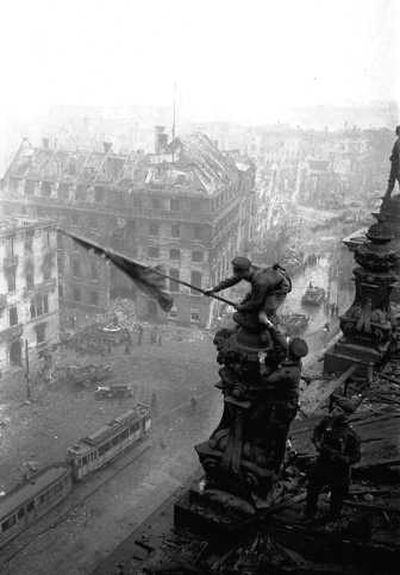Staged WWII photo honored at exhibit

BERLIN – It’s an iconic image of World War II: Berlin has fallen and Soviet soldiers are hoisting the red flag over the Reichstag.
What most people don’t realize, however, is that the photograph isn’t capturing the historic moment. Yevgeni Khaldei staged the scene on May 2, 1945 – three days after the Soviets captured Germany’s parliament building.
The picture is the centerpiece of an exhibit, “Yevgeni Khaldei – The Decisive Moment,” that bills itself as the first comprehensive retrospective of the photographer’s World War II work.
The show at Berlin’s Gropius-Bau museum reveals the extent to which Khaldei’s work as a war correspondent and later a staff photographer for Pravda blurred the boundaries between photojournalism, art and propaganda.
For Russians, the Reichstag photo is as potent a symbol of victory as Associated Press photographer Joe Rosenthal’s shot of the U.S. flag being raised on the Japanese island of Iwo Jima is for Americans.
But the Reichstag image was heavily manipulated: Smoke in the background was etched later on the negative, to create the impression the battle was still unfolding.
In another version, a soldier’s wristwatches have been deftly edited out lest they give the impression he looted them.
Ernst Volland, one of the exhibit’s curators, calls the Reichstag photo “120 percent propaganda” – especially because it was made according to Soviet dictator Josef Stalin’s specifications.
“Stalin badly wanted the combination of Reichstag and the red flag,” Volland said.
Another image shows a tank planted in front of the Brandenburg Gate, while a straight line of fighter planes soar overhead. Closer scrutiny reveals that the tank is a cutout from another picture and the planes are painted into the frame.
Khaldei saw no ethical problem with the doctoring. If challenged about a photo’s truthfulness, Volland said, the photographer would simply reply: “It’s a good photo. I made it. Auf wiedersehen.”
Khaldei toiled in obscurity for most of his life and lived out his retirement in a small Moscow apartment on a modest pension until his death in 1997.
The retrospective of more than 200 images was put together by private photography collectors Volland and Heinz Krimmer, who have been instrumental in bringing Khaldei’s work to a broader public.
“Khaldei’s photos are in every German schoolbook. His images are known but the man behind them is not,” said Krimmer. Khaldei never considered himself an artist and sold his work in small quantities from his apartment.